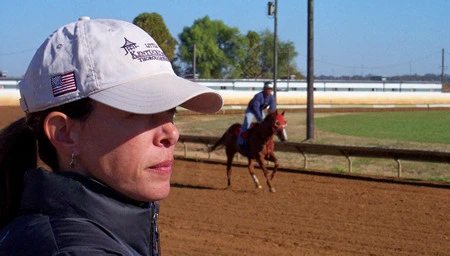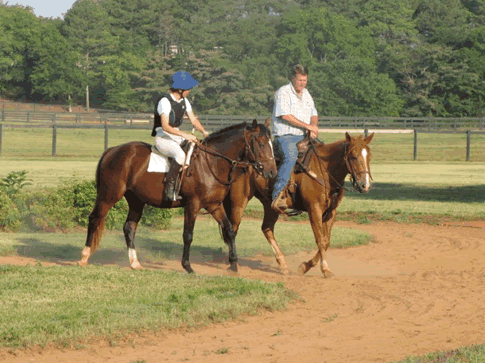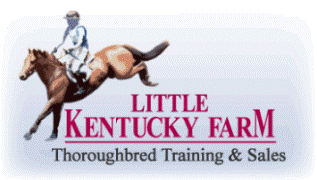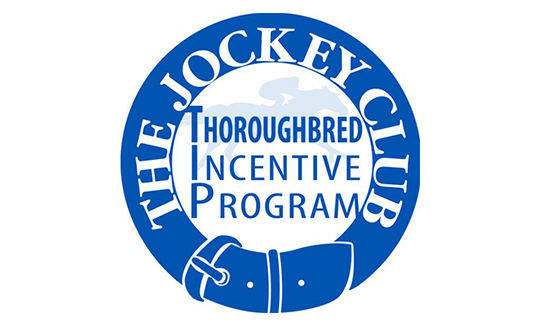Little Kentucky Farm
Thoroughbred Training and Sales
Race to Sport
Out of the desire to create a horse with speed, endurance and heart, the Thoroughbred breed came to life in England in the 1600’s. Their ancestry derives from three stallions who were brought to England from the Middle East – the Byerly Turk, the Darley Arabian and the Godolphin Arabian.
Breeding from only the best stallions and mares, has produced a rich history that is well documented throughout breeding and racing circles. The first of its kind, the Thoroughbred Stud Book was created by Englishman James Weatherby in the 1700’s. It documents the bloodlines of Thoroughbreds in great detail. It is still being publish today by Weatherbys via England’s Jockey Club.
History shows the first Thoroughbred to come to North America was the stallion Bulle Rock in 1730. Wealthy English and American owners started exporting horses and as the breed’s popularity grew, so did the first volume of the American Stud Book in 1873. It was published by Col. S.D. Sanders of Kentucky, later to be taken over and continues to be published through the Jockey Club.

Dosage Profiling
Do the numbers really mean anything?
Deciphering your ex-racehorse’s Dosage Profile may be part of a missing link and could answer questions as to the type of horse you own. Have you ever sat on a Thoroughbred and wondered what drives them to be the way they are? Do you event a Thoroughbred and feel like your horse could gallop all day long and never tire? Do you have a Thoroughbred that barely needs any conditioning?

Jockey Club registered Thoroughbreds have Dosage Profile numbers that look a lot like lottery numbers. Personally, understanding how to put together a profile is about as interesting as watching grass grow and that old sleepy feeling I use to get while sitting in Statistics class starts to creep in. But by understanding a Thoroughbred’s profile, some may think it can enable them to make predictions about it’s future.
A Dosage Profile (DP) can be thought of as a mathematical equation to classify Thoroughbred pedigrees into different racing categories. It is suppose to assist in verifying what type of race the horse will be successful in running such as a Grade I (Kentucky Derby/Breeder’s Cup), Grade II (Louisiana Derby) or Grade III (Gotham Stakes). The lower level types of races are in the following order: Non-Stakes races, Classified Allowance races, Claiming races, Maiden Special Weight races and Maiden Claiming races.
Profiling predicts inherited traits based upon sire ancestry and how well a horse is going to run in the dirt or on turf, if it will be a sprinter or have stamina to run long distances. The offspring’s sires must be listed on the Chef-de-Race list in order to have Dosage points. Breeders, bloodstock agents and those who bet on races believe it to be a serious tool for rating a horse before it has ever been conceived. It’s an intricate piece of information (that can be confusing), generated by meticulous record keeping and configurations.
The Chef-de-Race list is updated annually and is a ‘who’s- who’ of old and new Thoroughbred sires. The list is sometimes referred to as the Masters of the Breed listing. Each stallion has points that are inherited to their offspring. The points start out higher in the 1st and 2nd generation of foals and gradually become lower in later generations as the sire’s influence or bloodlines lower. For example, 1st generation will be scored 16 points, 2nd generation – 8 points, 3rd generation – 4 points, 4th generation – 2 points. Sires can be named in more than one category and therefore have points in both divisions.
The Dosage Profile’s (DP) 5 categories or 5 numbers, predict the running ability offspring will inherit via the sire/s. The numbers can be found at the top of a Thoroughbred’s pedigree report next to the name, where stallions are placed under the categories of Brilliant (speed) – Intermediate (speed) – Classic (middle) – Solid (stamina) – Professional (stamina). Categories correspond to a range of distance potential. Classic represents the “ideal” balance of speed and stamina and is usually divided in half with points being added into the Brilliant/Intermediate categories and then the other half into the Solid/Professional slot.

DP = 11-14-13-4-0 (42) DI = 3.00 CD = 0.76
Juddmonte Farms
State Bred: KY
Winnings: 27 Starts: 7 – 6 – 4, $1,849,452
Retired at Old Friends in Kentucky
The Dosage Profile is made up of 2 stats: the Dosage Index (DI) and Center of Distribution (CD). The Dosage Index (DI) is the ratio of inherited proponent speed to stamina in the pedigree. It is derived from the DP by dividing the speed component (the Brilliant points plus the Intermediate points plus one-half the Classic points) by the stamina component (one-half the Classic points plus the Solid points plus the Professional points). The DP is split down the middle through the Classic aptitude group. The numbers on the left side represent speed while those on the right side represent stamina. The Center of Distribution (CD) marks the balancing point of all the numbers in the profile and indicates a specific distance that an individual Thoroughbred can run.
For example, Storm Cat’s highlighted Dosage Profile: (USA) br. H, 1983 DP = 11-8-10-1-0 (30). DI = 4.00 CD = 0.97 . Storm Cat’s Dosage Index interprets him to be a speed horse.
The higher the number is in the Dosage Index (DI) between the scale of 1.0 to 4.0, the more speed a horse is to have. A horse that scores higher than 1.0 for the Center of Distribution (CD) will have lower distance potential.
So the next time you gallop through the finish on Cross Country after having a clean and stellar round, possibly consider your Thoroughbred’s Dosage Profile as playing a part. It could be a hidden formula that gives you a ‘jump’ ahead of the competition.
From Race Horse to Sport Horse
Many new Thoroughbred owners find that their horse is quite different from the Quarter Horse or other breed they had as a child. Taking a horse off the track does require maintenance and an understanding of the racing world in which they’ve lived. Owners will find that their personalities are more prone to be energetic and that their bodies will continue to change physically as they make the transition from a race horse into a sport horse. I often explain to buyers that if you are unable to commit to a schedule of training and work with a Thoroughbred, then do not purchase one. Ex-race horses are likely be the type of horse that is accustom to having a job, and if you cannot invest your time and money into a Thoroughbred, then you need to consider a different breed of horse that would fit into your lifestyle.
I’ve discovered that if you dedicate yourself for 4 to 6 months in putting the time and training into an ex-racer, the payoff will be satisfying for you and the horse. The trick is not to become impatient, take short cuts, become intimidated or lose interest. If there is a knowledgeable horseman with Thoroughbred experience that you trust, I would definitely work with them.


Bermuda and Coastal hay is traditionally known to cause impactions and doesn’t have much nutritional resources. We feed Orchard/Alfalfa hay, Timothy/Alfalfa hay or straight Alfalfa because it helps put on weight and gives the horse an added glow. As for grain, feeding something that is high in fats and feeding the correct amount is very important. Be sure that you balance the amount of food, to the amount of work the horse is in. The metabolism of a Thoroughbred will be higher and they will require more food.
An important note to all horse owners whether they have a Thoroughbred or another breed is to STOP GIVING TREATS! Many people think it’s a nice way of showing the horse affection or think that they can give a treat to reinforce training. Peppermints, carrots, apples, cookies, etc., are some things people give, and I’ve found it generates bad behavior. Begging, pawing the ground, bobbing the head, kicking at the stall walls, getting into your ‘space’, being mouthy and biting or nipping is something handlers can correct – and that is usually when I’m called in to correct the bad behavior.
Horses should stand quietly in the cross ties, should freely walk on a trailer, stand immobile for the farrier, stand immobile while mounting, etc. via consistent handling and use of touch and voice commands. Nothing can tick off a farrier more than to have an owner cramming peppermints down a horse’s mouth and the horse jerking its body around while the farrier struggles to keep their composure and temper.
In the morning with work outs and prepping for the day’s upcoming race, the horses will be handled by a variety of people hired on the team. They’ll be with the groom, the exercise rider, the trainer and stall workers. Taking the time to watch your horse’s habits and getting to know their personality will help you understand their individual characteristics, and you can see if they are girthy, if they’re possessive of their stall space or if they enjoy interacting with people.

Some Thoroughbreds will have been stabled at the track for many weeks, walking on the hot walkers and not be able to graze or have turnout time in a pasture. Be careful of the amount of time you let them graze for the first week. They’re not use to grass and you may see their manure will be very runny. The next thing to watch out for is that they may become body sore from the sudden ‘freedom’ they’re allowed to have in the field. They’re also more prone to loosing shoes if they’re running around, so make sure their shoes have clips to help secure them.
At the track, the horses are not shod with clips, but rather light aluminum racing shoes. When replacing their shoes with those that have clips, be careful as to how tight your farrier makes them. Tight clips will initially make their hooves sore. Thoroughbreds can be more active in the fields, so my horses go out with bell boots and splint boots as a precautionary.

The Thoroughbreds for sale at the farm are quality horses. What sets these horses apart from others is not only their correct conformation, soundness and ability, but the fact that they are well represented. We take great pride in our Thoroughbreds and are confident in our training and care to have them become successful athletes.
Your Ex- Race Horse . . . This is where it begins.
The day starts at the crack of dawn, as buckets are filled with oats and the hay is piled high as soft nickers trickle their way down each stall. There’s always a big pot of coffee brewing and the sweet mix of its aroma along with the heavy scent of leather hangs through the air. Everyone is waking up, stretching and yawning and as in most racing stables, looking forward to what lays ahead.
I grab my tack and pass through the office, and as I do I have their eyes looking down on me. So many photos . . . black and white irreplaceable photos of past winners, their grooms and beaming faces smiling at anyone who passes near. In one photo, stands HRH Queen Elizabeth wearing the lovely fashion of the 1960’s with lilac colored gloves as she holds a large silver cup in the Winner’s Circle. I go through my usual routine each time I pass, repeating their names to myself – El Senor, Decidedly (Kentucky Derby winner), Northern Dancer (Derby and Preakness winner), Nijinski (leading Broodmare sire), Tap Shoes, Riva Ridge and I am in awe that they were once here.
Every season a fresh batch of young fillies and colts come in from the fields to be broke and prepped for their freshman year as a racehorse. In a way it’s a type of graduation where they’ve learned how to count and do their A B C’s. Now, playtime is over and it is time to get serious. By 2 years of age, the Thoroughbred is very advanced in their training and handling compared to the average horse. They’ve become accustom to wearing full tack, how to be groomed and bathed daily, being tied and exercised on a hot walker, adjusting how to walk, trot, canter and gallop, exiting from the start gate and eventually leaving home on a big semi. It all has its place and time in the education and future success of each Thoroughbred on the farm, and if they’re lucky enough, they may even one day have their photo placed on the wall along with the others.
Each person involved has a particular ‘duty’ in handling the horses and the horses are very aware of it. I compare it to a pit crew at a car race, where there is a set routine and generally a time allotted to each horse. I’ve always told people how Thoroughbred horses are creatures of ‘habit’, where they become accustom to the daily schedule and this is something one needs to understand when working with them whether at the track or in transition to become a show horse.

We always tack up in the stalls, putting the bridles over the halters, smoothing out the saddlecloths and lightly cinching the girth. A groom tacks the horse and then the hot walker person holds the horse as I get a leg up. Mounting blocks are never used, as the routine is to be as similar to what the horses will experience once at the track.
Every moment around the youngster is a learning experience for them. I always support myself over the horse’s withers during the leg-up and then gently lower myself. I never flop down or smack my legs against the girth area after getting legged up. We talk a lot to the horses in a low tone, rub their necks and make them feel safe. The hot walker person then circles me around in the stall until the horse relaxes through the spine and accepts my lower leg at the girth. With the thin exercise saddles on, you can easily feel the back of the horse. If you have a spine creeping in between your butt cheeks, I usually have the hot walker turn me in the stall a few times until the spine starts to relax down.

Once out of the stall, I tightened the girth (always while in the saddle), and my job as an exercise rider is to encourage the young Thoroughbred to move forward from my leg, torso and voice. In the early training stages, we stay inside the shed row for a full week prior to going out to the track and use a nice quite lead pony a few feet in front of us to follow. The lead pony is bombproof and often settles a young Thoroughbred and gives them confidence and security. There is an occasional over active colt feeling his oats and may bump into the rear end of the lead pony and want to play. This is when I nudge them forward, keeping my hands low and soft and clucking them on. Training a young racehorse to concentrate and develop a solid work ethic early on is extremely important.
We invest thorough and correct training into each horse so that once they leave the farm, they’ll have had a great start in their careers and the odds won’t be so much against them. I am also very aware that they may not make it at the track, and if I can teach the horses the proper basics early on, then they can develop into nice show horses (especially Eventers).

The shed row has a mix of dirt and sand around the perimeter of the stalls with a tall ceiling that allows for indoor workouts. December through March is when we start to break the babies and because you can never depend upon the weather that time of year, riding around the indoor path is great. Something a lot of people don’t realize is that ex-track horses do really well in indoor arenas simply because of this early training experience of working inside.
After the colts and fillies are backed, the next step is to have the young horses moving forward at a trot, keeping a pace and getting physically conditioned. Some can be fussy with their heads or lean into your hands, while others trot happily around with ears perked. As a rider, you’ve got to not only be fit and have stamina but you also need to be versatile and aware that every horse is an individual who requires respect. By March, the training schedule has picked up quite a bit and the workload has increased, again with the intent of preparing the horses either for the track or for the sales.

After a couple days of following the lead pony, we mount outside the stalls and work our trot sets without the pony. You can notice a difference in the pace and attitude of the youngsters when their ‘security blanket’ is taken away, as they look for the lead pony and suck back from my leg.
So now we come into another phase of training, and teach independence and require the colts and fillies to really listen to what the rider is saying to them. They even need to learn what the stick means. Their usual response is with a question, such as, “Why are you tapping me with that annoying thing? I guess I’ll just slow down or stop altogether!” It’s a strange reaction that you may not expect, but in time they adjust and learn that a tap on the shoulder or behind the leg means to go faster.

Again, it takes a few days to adjust and learn to move freely forward. We will also add another colt or filly in the line up and have them work around together prior to going to the training track. It’s really interesting to see where their minds are at this moment because some become a bit competitive and want to be up front. Some will speed up in the turns and some will decide to slow down along the long side of the shed. This is when it’s helpful to follow up with the trainer and communicate what we’re feeling on top of the horse so that there is a game plan on what to watch out for once on the track.
When the rides are over, the babies are cooled out either on the hot walker or hand walked, brushed and then taken back out to the pastures to graze and play until the next day. I gather up all the equipment and make my way back through the office to the tack room where again, I’m met with those faces staring down at me from the walls. I don’t walk too quickly through this part of the barn. Everyday when I look up at those photos, it is as if I am looking at them for the first time – I never tire of them but rather finish my day with a habit I’ve gotten myself into of repeating their names to myself, “El Senor, Decidedly, Northern Dancer, Nijinski, Tap Shoes, Riva Ridge . . . ”









